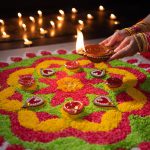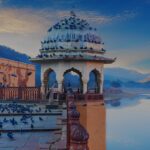The Limboo Homestay in Yoksum is an oddity in Sikkim. The charming family from the Limboo community who runs the homestay in West Sikkim are vegetarians and they don’t serve meat in their homestay. This came as a surprise for one of our explorers from the Destination Knowledge Centre who stayed there for 3 nights and almost carried pork as a gift for the family. The Limboos, as a community, are voracious meat-eaters. No festival for them is complete unless a pig is slaughtered. Our explorer was told by the wife that this is because of their Guru (spiritual master) who preaches non-violence as a key to a happy life. “So you are Buddhist ?” “Well, we are. But we also have our protector deities, we have our shamans, we have the blessings of Mount Kanchenjunga (the third highest mountain in the world) and we have our Guru. So we combine everything and try to lead a happy contented life.”

This is interesting because Yoksum was where the Kingdom of Sikkim was established in the mid-17th century by the Three Patron Saints from the Nyingmapa sect, the oldest school of Tibetan Buddhism who were forced out by the 5th Dalai Lama when he assumed full control of Tibet and its religious institutions with the help of the Mongols. They enthroned the first Chogyal (King) of Sikkim in Yoksum whose line continued to rule Sikkim till it became a part of India in 1975. Lhatsun Chenpo Namkha Jigme, one of the three patron saints while converting the indigenous communities to Buddhism didn’t interfere with or challenge the already prevalent shamanic traditions where the land was sacred, where ancestral gods and the protector deities resided within the landscape and its mountain peaks, and where the cause of illness and misfortune was to be found within this shamanic worldview of the locals.

His ritual text “Nesol”— meaning “an offering to powerful sacred places” was a celebration of Sikkim as sacred hidden land and an offering to Mount Kanchenjunga, Sikkim’s mountain deity, and to all the deities of the land. The Nesol is still one of the most sacred and important rituals in Sikkim, as much in the Buddhist monasteries as in the private homes of the locals.

The fact that the shamanic worldview of Sikkim remains unchallenged till date is not only due to the tolerance and inherent shamanic nature of Nyingmapa Buddhism which dominates the religious and spiritual space. The most respected Sikkimese Buddhist masters were not reincarnated monks of powerful celibate monastic orders such as that of the Dalai Lama. They were farmers who led a married life and were shamanic practitioners better known for their non-conformity and irreverence towards any form of authority. The most important state ritual of Sikkim is Pang Lhabsol—meaning “offering to the deities of the higher elevations”—the celebration of Mount Kanchenjunga, once treated as a witness for all socio-economic pacts by the different communities of Sikkim. Pang Lhabsol which follows Lhatsun Chenpo Namkha Jigme’s ritual text Nesol is very much a national shamanic ritual in the sense that it celebrates the renewal of Sikkim’s relations with the sacred land, its history, people, and protector deities every year.
Routing: Bagdogra – Darjeeling – Gangtok – Kalimpong – Bagdogra






Please tell me the best package for 4N 5D about Hotel and sight seeing including breakfast and dinner Gangtok – Darjeeling and lake for 3 person or 6person.
Please send an email to info@sita.in with your requirement and the team will revert.